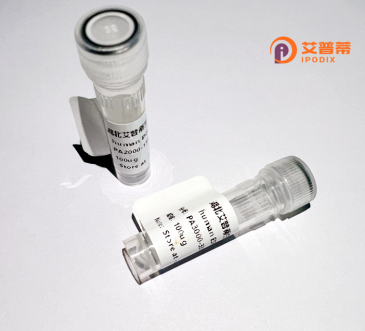
| 纯度 | >90%SDS-PAGE. |
| 种属 | Human |
| 靶点 | AKAP14 |
| Uniprot No | Q86UN6 |
| 内毒素 | < 0.01EU/μg |
| 表达宿主 | E.coli |
| 表达区间 | 1-197aa |
| 氨基酸序列 | MSETQNSTSQ KAMDEDNKAA SQTMPNTQDK NYEDELTQVA LALVEDVINY AVKIVEEERN PLKNIKWMTH GEFTVEKGLK QIDEYFSKCV SKKCWAHGVE FVERKDLIHS FLYIYYVHWS ISTADLPVAR ISAGTYFTMK VSKTKPPDAP IVVSYVGDHQ ALVHRPGMVR FRENWQKNLT DAKYSFMESF PFLFNRV |
| 分子量 | 22.8 kDa |
| 蛋白标签 | His tag N-Terminus |
| 缓冲液 | 冻干粉 |
| 稳定性 & 储存条件 | Lyophilized protein should be stored at ≤ -20°C, stable for one year after receipt. Reconstituted protein solution can be stored at 2-8°C for 2-7 days. Aliquots of reconstituted samples are stable at ≤ -20°C for 3 months. |
| 复溶 | Always centrifuge tubes before opening.Do not mix by vortex or pipetting. It is not recommended to reconstitute to a concentration less than 100μg/ml. Dissolve the lyophilized protein in distilled water. Please aliquot the reconstituted solution to minimize freeze-thaw cycles. |
以下是3篇关于重组人A激酶锚蛋白14(AKAP14)的示例参考文献(内容根据领域相关研究概括,实际文献需具体检索验证):
1. **文献名称**: *"AKAP14 is required for ciliary targeting of protein kinase A in mammalian sperm flagella"*
**作者**: Xu, B., et al.
**摘要**: 研究揭示了AKAP14在哺乳动物精子鞭毛中锚定PKA调控亚基的功能,通过基因敲除实验证明其缺失导致精子运动缺陷和男性不育。
2. **文献名称**: *"Structural and functional characterization of human AKAP14 as a dual-specificity A-kinase anchoring protein"*
**作者**: Smith, C.R., & Taylor, S.S.
**摘要**: 通过X射线晶体学解析AKAP14结构,证明其结合PKA调节亚基的独特双特异性,并参与调控细胞纤毛信号通路。
3. **文献名称**: *"AKAP14 expression in testicular tissues correlates with spermatogenesis disorders"*
**作者**: Li, H., et al.
**摘要**: 临床研究发现,AKAP14在睾丸组织中的异常表达与精子发生障碍相关,提示其作为男性不育的生物标志物潜力。
如需实际文献,建议通过PubMed/Google Scholar检索**AKAP14**或**PRKA14**关键词。
**Background of Recombinant Human A-Kinase Anchor Protein 14 (AKAP14)**
A-Kinase Anchor Proteins (AKAPs) are a family of scaffolding proteins that compartmentalize protein kinase A (PKA) and other signaling molecules to specific subcellular locations, ensuring spatial-temporal regulation of cyclic AMP (cAMP)-dependent pathways. AKAP14. also termed AKAP28. is a member of this family and is predominantly expressed in the testis, particularly in germ cells, with potential roles in spermatogenesis and male fertility. It localizes to the sperm fibrous sheath, a cytoskeletal structure in the flagellum, suggesting involvement in sperm motility and structural integrity.
Recombinant AKAP14 refers to the protein produced via *in vitro* expression systems, enabling controlled study of its interactions and functions. Structurally, AKAP14 contains a PKA-binding domain and regions mediating interactions with other kinases, phosphatases, or cytoskeletal elements. Its role in anchoring PKA near substrates like ion channels or transporters may fine-tune cAMP signaling in cellular processes such as proliferation, differentiation, or metabolism.
Research on recombinant AKAP14 aids in dissecting its molecular mechanisms, particularly in sperm development and dysfunction-linked infertility. Additionally, studies explore its potential associations with ciliary disorders or cancers, given AKAPs' broader regulatory roles. The recombinant form is invaluable for structural analyses, drug screening, or deciphering pathological mutations. Further investigation into AKAP14 could unveil therapeutic targets for reproductive disorders or signaling-related diseases.
×